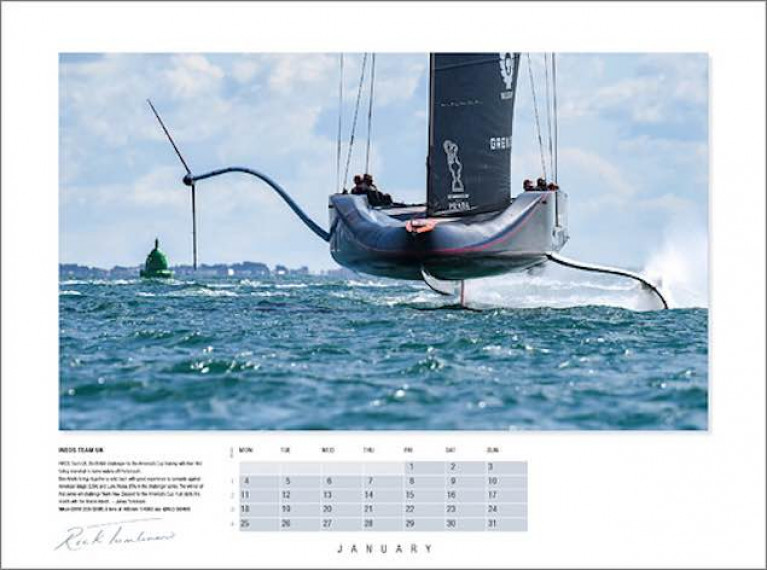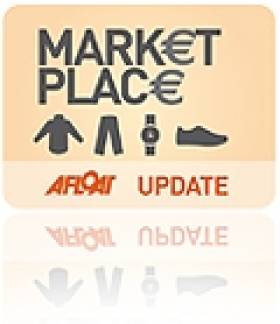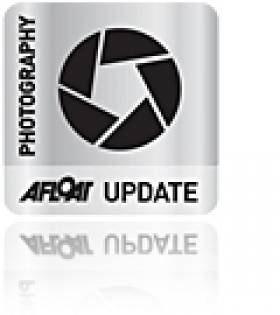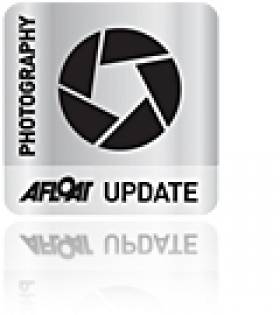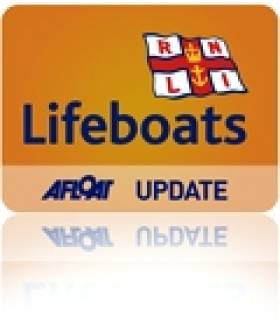Displaying items by tag: Rick Tomlinson
Rick Tomlinson Hosting Fastnet Rock Photography Workshop
Here’s a rare opportunity to join renowned marine photographer Rick Tomlinson in the field for a special workshop at Fastnet Rock during this summer’s Rolex Fastnet Race.
From 23-27 July, four lucky marine photography enthusiasts will join Rick on a professionally skippered 50-foot charter yacht out of Baltimore in West Cork, which will be stationed at the famous rock in prime position to capture the boats rounding in this 50th edition of the legendary race.
Depending on weather, the party go to a small harbour in the hours of darkness. But the group will spend as much time as possible at the rock, with provisions for four full days at sea.
There’s also the chance of seeing some of Ireland’s bounty of marine wildlife in the area.
Places are £1,800 per person which includes accommodation onboard in a shared cabin (flight to Cork not included). For more see Rick Tomlinson’s website HERE.
Chance to Join Orca and Humpback Adventure in Norway With Top Yachting Photographer Next Month
Join top yachting photographer Rick Tomlinson for a week-long adventure photographing orcas and humpback whales as they hunt for the herring in the fjords around Tromsø in Norway from 9-16 November.
The group will board the expedition yacht Qilak in Tromsø and explore the fjords close by, photographing the whales by day then anchoring each evening in remote coves away from all light pollution to hopefully see the northern lights.
This exclusive trip with the Cowes-based marine snapper is limited to just six guests, priced from €3,100 per person including full board.
For more information, get in touch Rick Tomlinson at [email protected].
Photographer Rick Tomlinson's Portfolio Calendar 2021 is Out Now!
Cowes-based photographer Rick Tomlinson's Portfolio Calendar is now available and features 12 months of spectacular sailing images.
Now in its 33rd year, Action and Art has always been the theme of Rick's Portfolio Calendar.
This year's pictures include action from the TP52s in Cape Town, Sir Ben Ainslie's Ineos Team UK racing in The Solent, plus art from the Fast 40 Class and an amazing shot of an Orca Whale in front of Pelagic in the Falkland Islands.
Wall hanging 56cm x 42cm £19.95 + P&P. Order here
Rick Tomlinson 2016 Sailing Calendar Is Ideal Christmas Gift
The 28th edition of the highly acclaimed Rick Tomlinson Portfolio calendar is now available directly from the Afloat.ie marketplace site HERE. The ideal Christmas gift for the sailor in your life features 12 spectacular images from recent assignments around the world.
This year's pictures include action from The Volvo Ocean Race at Cape Horn, the Royal Yacht Squadron Bicentenary Regatta, Sir Ben Ainslie’s Americas Cup challenge, sailing in Greenland, plus other action and art from the international racing circuit.
Action and art has always been Rick’s style, “Each picture will hang on the wall for a month and offer the viewer something that perhaps they didn't see on the first look” says Rick, “my particular favourite this year is the shot of Brunel off Cape Horn.”
Rick has raced in 4 Whitbread Round the World Races, on Drum, The Card, Intrum Justitia and Team EF. Photographs taken onboard Drum started his career, becoming one of the most highly acclaimed marine photographers in the world. High profile projects include the Volvo Ocean Race, Americas Cup, and many SuperYacht commissions. He was recently the Official photographer for Team SCA.
Rick works from his gallery in Cowes - Isle of Wight, and travels the world on assignments for the worlds leading events and yachts.
Rick Tomlinson Sailing Calendar Out Now!
#ricktomlinson – The 27th edition of Rick Tomlinson's Portfolio and Desk Calendars are now available featuring 12 spectacular images from recent assignments around the world.
Action and art has always been Rick's style, "Each picture will hang on the wall for a month and offer the viewer something that perhaps they didn't see on the first look" says Rick.
For 2015 there is a great selection and variety, including action from the Volvo Ocean Race, the RC44 fleet in Lanzarote, Oman Sail at 40 knots and a great picture of the Round The Island Race fleet, plus other action and art from the international racing circuit.
Business 2 Business company overprinted calendars are also available to promote your business for a whole year. Company details are printed on each month spread including the cover.
Portfolio Calendar £17.50 plus p&p. Desk Calendar £7.50 plus p&p email [email protected]
Isle of Man marine photographer Rick Tomlinson will run a one day photography workshop based from the Royal Cork Yacht Club in Crosshaven on April 6th. This includes both onshore and on the water tuition with as much time as possible spent photographing on the water around Cork Harbour. Rick is also speaking at the RCYC Spring Cruising Dinner that evening.
The workshop has limited space so a high level of one to one tuition is assured and beginners and experienced photographers are welcome to take part. Rick will show how to take great yachting photographs and how to work efficiently on the water. You will also be guided through how to set up your camera and the workflow to edit pictures plus useful tips in Photoshop. Checkout www.rick-tomlinson.com for inspiration.
Special price for RCYC members and friends is just €200 per person.
Outline schedule for 1 day workshop
1000 Meet at the RCYC: Introduction to the workshop and how to set up your camera before we take to the water.
1100 Out on the RIB taking pictures on Cork Harbour where Rick will give ideas and instruction on taking pictures of the racing yachts.
1300 Pub lunch probably on the Harbour somewhere, with informal discussion. (lunch is not included in the price)
1600 return to RCYC and review our pictures on the computer including post production importing and editing on the computer, Photoshop tips and techniques and digital workflows.
1700 finish.
What you need to bring: Camera equipment, laptop (optional), warm clothing, boots and wet weather gear. It can be very wet on the boat.
Individual places and groups of friends welcome.
Rick Tomlinson Yachting Photography Courses in Cowes
In response to many requests International Yachting Photographer Rick Tomlinson will give a one day and a two day photography workshop this Spring. The one day session is on March 17 and two days March 29/30 2013
Both will take place from Cowes, Isle of Wight, with both onshore and on the water tuition with as much time as possible spent photographing from Rick's 6.5m RIB.
Limited to just 5 people a high level of one to one tuition is assured so beginners and experienced photographers are welcome to take part. Rick will show how to take great yachting photographs and how to work efficiently on the water. Checkout www.rick-tomlinson.com for inspiration. You will also be guided through how to set up your camera and the workflow to edit pictures plus some usefull tips in Photoshop.
March 17 is a one day workshop working around the Solent Spring Series from my 6.5m RIB. With the onshore breifing and post race workflow and analysis that will take place in the new Studio in Cowes Yacht Haven. Price per person £250 includes lunch. 3 persons are required to run the course (5 max)
Outline schedule for 1 day workshop:
0900 Introduction to the workshop and how to set up your camera before we take to the water.
1000 out on the RIB taking pictures on the Solent where Rick will give ideas and instruction on taking pictures of the racing yachts.
1300 return to Cowes and review our work on the computer including post production importing and editing on the computer, Photoshop techniques and digital workflows.
1500 finish.
March 29 & 30 is a two day workshop that will follow the Easter racing events. Starting at 0930 on Friday March 29 and finish at 1700 on Saturday March 30. 2 day workshop price £400 per person. 3 persons are required to run the course (5 max)
Outline schedule for 2 day workshop:
0930 Introduction to the workshop and how to set up your camera before we take to the water.
1030 out on the RIB taking pictures on the Solent where Rick will give ideas and instruction on taking pictures of racing yachts.
1500 return to Cowes and review our work on the computer including post production importing and editing on the computer, Photoshop techniques and digital work flows.
1700 finish for the evening. Time for a beer!
Day 2
0900 Meet for the days briefing, discussion on what we have covered so far, ideas and inspiration.
1000 Out on the water shooting yachts racing and dinghies.
1500 onshore computer editing, show time and de-brief
1700 finish the course.
The exact timetable will depend on the weather, and the interests of those taking part.
What is included: 1 or 2 days of tuition, course notes, onboard picnic lunch on both days. Lifejackets.
What you need to bring: Camera equipment, laptop (optional), warm clothing, boots and wet weather gear. It can be very wet on the boat.
Not included: Overnight accommodation, evening meal or breakfast. We can recommend B&Bs and travel arrangements.
New Studio office; 2nd Floor, Cowes Yacht Haven, Cowes, Isle of Wight, PO317BD.
To book contact Rick on 01983 248512 or email [email protected]
Rick Tomlinson Addresses 'Sailing By the Lee' Luncheon
Today's 'Sailing by the Lee' lunch in Cork in aid of the RNLI featured guest speaker Rick Tomlinson, the Round the World Photographer who hails from the Isle of Man.
The lunch began with a drinks reception sponsored by The Electric Bar and Restaurant of South Mall.
Tomlinson gave a 40 minute slide show that featured a selection of Antarctic images including maginificent wildlife photography. It was immediately clear to the 200 guests that not only does this photographer have a great eye but also a strong techincal ability, his shots ranging from 360 degree fisheye to telephoto lens shots taken from helicopters.
As always it was a packed attendance at the Maryborough hotel for the start of season function, organised by Kinsale's Susie Elliott. This years lunch included host RNLI Governor Peter Crowley, sailmaker Des McWilliam, Afloat.ie's Claire Bateman, Vinnie O'Shea, commodore of SCORA, Gary and Susan Horgan of Sovereigns Cup, Race officer Alan and Mary Crosbie and many, many more. Scroll down for photos (by Bob Bateman) below!
During the lunch, Peter Crowley paid a special tribute to Rick on his remarkable career, "I wish to acknowledge Rick's absolute dedication; commitment and enthusiasm in representing those connected to the sea, in bringing the thrills and excitement of the Volvo Ocean Race back to us at home and capturing the ongoing challenges and adventures of the international maritime community. Rick has also been most important to us over the years, as through his work, he has also captured with his talents the volunteer life saving work of the RNLI."
Rick Tomlinson is best known for capturing the Southern Ocean at its most treacherous from the decks of various yachts in the Whitbread Round the World Race/Volvo Ocean Race. Born in 1958, Rick grew up on the Isle of Man, where he established a serious interest in sailing. Rick's enthusiasm for photography began while he was boatbuilding and sailing. Yacht racing aside, Rick has extended his skills into expedition and project photography to such places as the Arctic and Antarctic, Chile, Alaska, Caribbean and Africa, together special assignments for the RNLI.
Speaking at the event, Kinsale RNLI Fundraising Secretary Susie Elliott stated, "It has been a remarkable year for Kinsale RNLI. Having opened our boathouse just over a year ago, we continue to work to raise the funds needed to meet the construction costs. Our sponsors and supporters for this year's event have been extremely generous and we are very grateful to them, particularly given the challenging economic climate.
Related Safety posts
RNLI Lifeboats in Ireland
Safety News
Rescue News from RNLI Lifeboats in Ireland
Coast Guard News from Ireland
Water Safety News from Ireland
Marine Casualty Investigation Board News
Marine Warnings


























